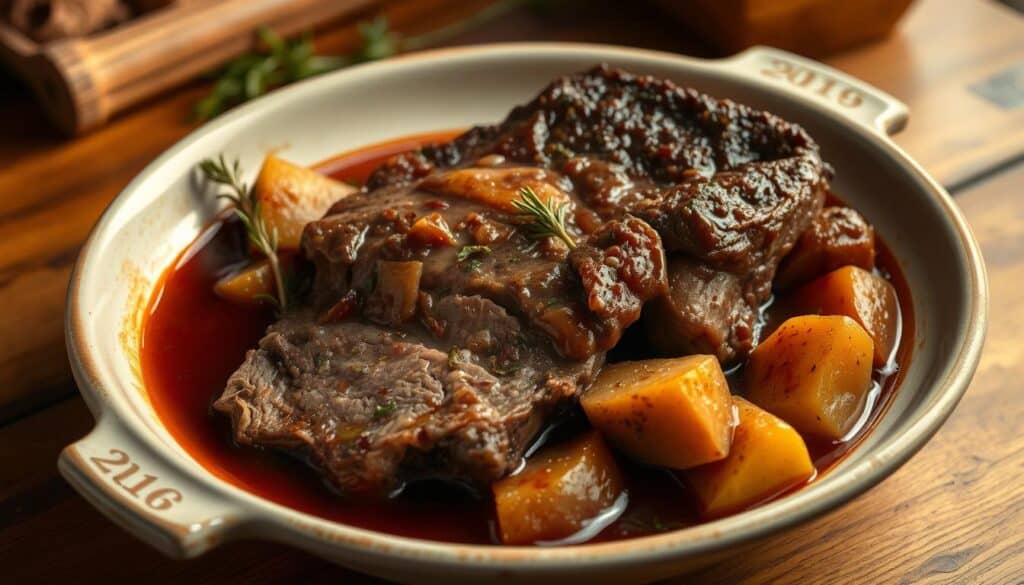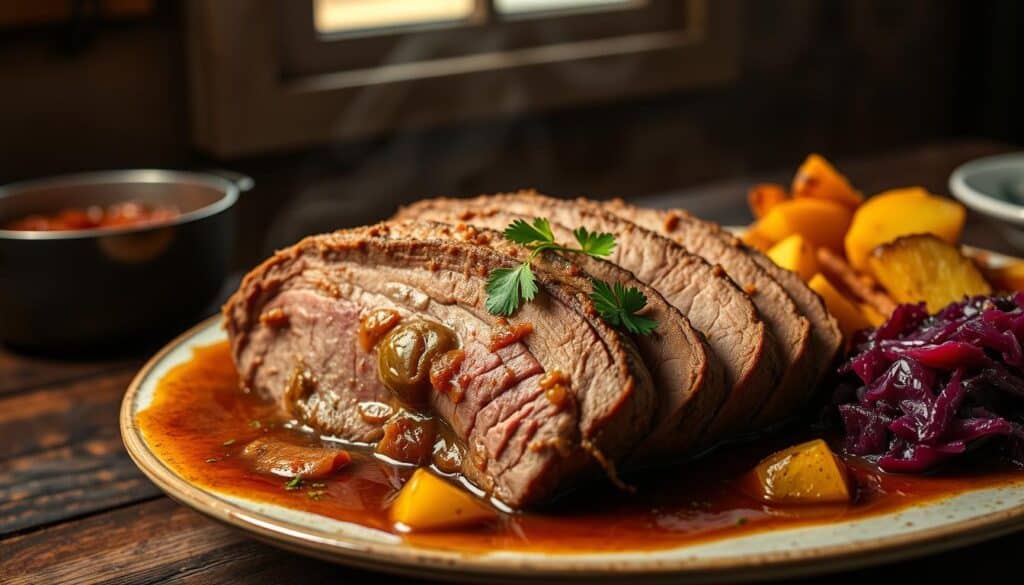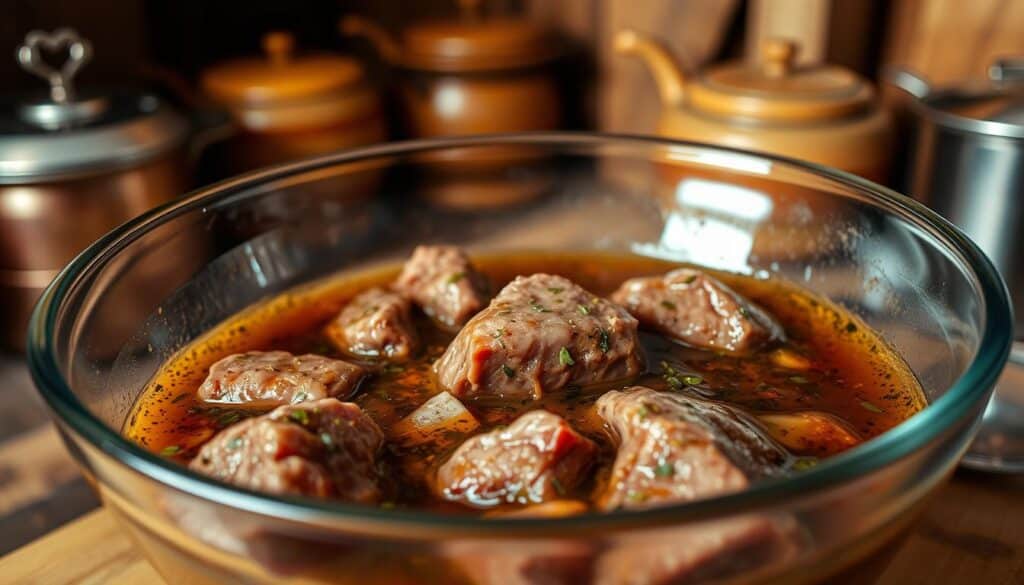There’s something special about a dish that connects us to history and tradition. For me, Sauerbraten: Savory Marinated Pot Roast is more than just a meal—it’s a journey through time. This classic German pot roast, with its distinctive sweet-sour flavor, has been a staple for generations. The secret lies in its marinade, a blend of red wine, vinegar, and spices that infuses the beef with incredible depth.
Thank you for reading this post, don't forget to subscribe!What makes this recipe truly unforgettable is the balance of flavors. The tang of red wine vinegar, the subtle sweetness of gingersnap cookies, and the richness of slow-cooked beef create a dish that’s both hearty and elegant. Whether you’re a fan of traditional German cuisine or just looking for a new way to enjoy pot roast, this Sauerbraten recipe promises to delight your taste buds.
Over the years, I’ve perfected this family favorite, and I’m excited to share my tips and tricks with you. From the multi-day marinade to the final touches of gravy, this guide will walk you through every step of creating an authentic, mouthwatering Sauerbraten that your family and friends will love.

Key Takeaways
- Traditional German pot roast with a unique sweet-sour sauce
- Requires a multi-day marinade for optimal flavor
- Features red wine, vinegar, and spices for a rich taste
- Perfectly cooked beef with a tender, juicy texture
- Incorporates gingersnap cookies for a unique twist
- Ideal for special occasions or hearty family meals
Introduction: My Journey with Sauerbraten: Savory Marinated Pot Roast
My love affair with Sauerbraten began during a family trip to Germany, where I first tasted this iconic dish. The combination of tender beef, tangy vinegar, and sweet spices left an indelible mark on my palate. It was more than just a meal—it was a cultural experience that I wanted to recreate back home.
Why This Recipe is Special to Me
I cherish this recipe because it connects me to my heritage. The marinade, made with red wine, onions, and spices, is a tradition passed down through generations. Each ingredient plays a vital role, much like the stories my family shares around the dinner table.
My First Encounter with Authentic German Flavors
During my visit to a small German village, I was introduced to the rich flavors of Sauerbraten. The dish was served with braised red cabbage and potato dumplings, creating a harmonious balance of flavors. This experience inspired me to perfect my own recipe, ensuring every bite captures the essence of tradition.
The marinade process, which takes several days, is crucial for developing the dish’s depth. The slow-cooked beef becomes incredibly tender, while the gravy adds a velvety texture. This recipe is more than food; it’s a way to share love and tradition with every serving.
Sauerbraten: A marinated pot roast, slow-cooked in a sweet and sour sauce.
This beloved German dish stands out for its tender, flavorful beef and rich, balanced sauce. The heart of Sauerbraten lies in its marinade and slow-cooking process, which infuse the meat with deep, complex flavors.
The marinade, a mix of red wine, vinegar, and spices, works its magic over several days, ensuring the beef becomes exceptionally tender. After marinating, the pot roast is slow-cooked for about 3½ to 4 hours, creating a velvety texture that’s both hearty and elegant.
The sauce is a perfect harmony of sweet and sour, enhanced by ingredients like gingersnap cookies, which add a unique twist. Each step, from the initial marinating to the final browning, is crucial for achieving that authentic taste.
| Component | Purpose | Duration |
|---|---|---|
| Red Wine & Vinegar | Marinade Base | 2-3 Days |
| Spices & Vegetables | Flavor Enhancement | 3½-4 Hours |
| Gingersnap Cookies | Sweetness & Thickening | Added During Cooking |
This recipe strikes a balance between simplicity and sophistication, making it perfect for both special occasions and cozy family meals. The precise timing and careful integration of ingredients ensure a dish that’s nothing short of extraordinary.

Essential Ingredients for Authentic Sauerbraten
Creating an authentic Sauerbraten requires careful selection of ingredients to achieve that perfect balance of flavors. Each component plays a vital role, from the tender beef to the secret ingredients that add a unique twist.
Key Proteins and Marinade Components
The star of the dish is a boneless beef round rump roast, typically weighing between 3 to 4 pounds. The marinade is where the magic begins, blending 1 cup of red wine vinegar and 3 cups of low-sodium beef broth. This mixture ensures the beef absorbs deep, rich flavors over 3 to 5 days, with a recommendation to turn the roast daily for even marination.
Secret Ingredients: Red Wine, Vinegar, and Gingerbread Cookies
The marinade also includes 2 cups of dry red wine and 1.5 cups of red wine vinegar, contributing to the dish’s distinctive flavor profile. For sweetness, 2 tablespoons of sugar balance the tartness, while 10 crushed gingersnap cookies add a unique flavor and help thicken the sauce. These cookies are a traditional touch, offering a sweet contrast to the tangy vinegar.
Seasoning is crucial, with 2 bay leaves, 10 whole black peppercorns, 8 juniper berries, and 6 whole cloves creating a aromatic blend. The final gravy is perfected with ⅓ cup of flour or sweet rice flour for a gluten-free option, ensuring a smooth texture.
Traditional German ingredients are key to authenticity, combining to create a festive dinner centerpiece. Each element, from the beef to the spices, works together to elevate the dish, making it perfect for special occasions or cozy family meals. For more details on this recipe, visit Sip and Feast.
Step-by-Step Guide to Marinating Your Beef
Marinating is the heart of creating a flavorful beef dish. This process ensures the meat absorbs all the delicious flavors, making it tender and juicy. Patience is key here, as the longer the beef marinates, the better the taste.
Understanding the Multi-Day Marinade Process
The marinade is a blend of red wine, vinegar, and spices. It’s important to let the beef sit for at least 2-3 days to soak up all the flavors. Each day, the meat should be turned to ensure even coating. This step is crucial for consistent taste.
Tips for Even and Flavorful Marination
- Always use a large, non-reactive container for marinating to prevent any metallic taste.
- Turn the beef daily to ensure all sides absorb the marinade equally.
- Keep the marinade refrigerated to maintain food safety and slow flavor infusion.
Key ingredients in the marinade include red wine, vinegar, garlic, and spices. These elements work together to create a balanced flavor profile. For more details on this recipe, visit Moroccan-Style Beef Tagine with Prunes for inspiration.

Cooking Techniques and Options for Sauerbraten
Cooking Sauerbraten can be adapted to fit various kitchen setups, ensuring everyone can enjoy this traditional dish. Whether you prefer the reliability of an oven, the direct heat of a stovetop, or the convenience of a slow cooker, each method yields delicious results with proper technique.
Choosing Between Oven, Stovetop, and Slow Cooker
The oven method is straightforward and requires minimal supervision. Preheat your oven to 325°F and braise the beef for about 3 to 4 hours. This hands-off approach allows the meat to develop a tender texture. On the stovetop, maintaining low heat is key. Simmer the beef in the cooking liquid for 3 to 4 hours, ensuring even heat distribution. For busy schedules, a slow cooker offers convenience, cooking the beef on low for 5 to 6 hours.
How to Achieve Perfect Browning and Tender Meat
Browning the beef before cooking is essential for flavor. Use a thick-bottomed pot over medium-high heat to achieve a deep, even sear. After browning, transfer the beef to your chosen cooking vessel. Monitor the cooking time closely; the beef is done when it’s fork-tender, typically after 3 to 4 hours in the oven or stovetop, and 5 to 6 hours in a slow cooker.
For the best results, use a rump or chuck roast. These cuts become tender with slow cooking. Pair the dish with sides like red cabbage for a balanced meal. If you’re looking for more braising tips, visit this guide for inspiration.
Crafting the Perfect Gravy
Transforming the cooking liquid into a rich, velvety gravy is the final step in creating an exceptional dish. This process requires attention to detail and a few secret ingredients to elevate the flavor.
Straining and Thickening the Cooking Liquid
Start by straining the cooking liquid to remove solids like onions and spices. This step ensures a smooth base for your gravy. Next, simmer the liquid for about 10 minutes to concentrate the flavors. To thicken, mix ⅓ cup of flour with a splash of cold water until smooth, then stir it into the simmering liquid. For an extra touch, add 10 crushed gingersnap cookies—they not only thicken the gravy but also deepen its flavor.
Enhancing Flavor with Crushed Gingerbread Cookies
The crushed gingersnap cookies add a unique sweetness and texture, balancing the tanginess of the vinegar. This traditional method creates a harmonious sweet-sour profile that complements the beef perfectly.
Quick Adjustments for the Ideal Sweet-Sour Balance
Taste the gravy and make any necessary adjustments. If it’s too tangy, add a pinch of sugar. If it’s not sweet enough, a drizzle of honey can help. Ensure the consistency is just right by monitoring the simmering time—thicker gravies develop as it reduces.
Each ingredient, from bay leaves to cloves, plays a role in crafting a sauce that’s nothing short of extraordinary. Precision in each step ensures a restaurant-quality finish that enhances every bite of your dish.
Serving Suggestions & Traditional Side Dishes
Bringing this hearty dish to the table is more than just serving food—it’s about creating a memorable experience. I love how Sauerbraten offers a chance to connect with tradition while adding your personal touch.
Classic Pairings: Potato Dumplings, Red Cabbage, and Spaetzle
For an authentic experience, pair the beef with traditional German sides. Potato dumplings (Kartoffelklöße) and braised red cabbage (Rotkohl) are timeless favorites. The soft texture of dumplings and the vibrant color of cabbage add delightful contrast to the dish. Spaetzle, a homemade noodle, also complements the rich flavors beautifully.
Presentation Tips for a Cozy Dinner
Presentation is key to making your meal special. Slice the beef thinly against the grain and arrange it on a platter. Surround it with your chosen sides to create a balanced look. Garnish with fresh herbs like parsley or thyme for a pop of color. This simple yet elegant presentation makes the dish feel extra special.
| Side Dish | Purpose | Preparation Time |
|---|---|---|
| Potato Dumplings | Provides a soft, comforting contrast | 30 minutes |
| Red Cabbage | Adds a vibrant, tangy note | 25 minutes |
| Spaetzle | Offers a homemade noodle texture | 20 minutes |
For a modern twist, consider adding a light salad or pairing with a refreshing wine. These touches can elevate your dinner into an unforgettable event.
Conclusion
As I reflect on my journey with this beloved dish, I am reminded of the joy it brings to every meal. Sauerbraten is more than just a recipe; it’s a celebration of tradition and the love that goes into every step, from the multi-day marinade to the final drizzle of gravy.
The heart of this dish lies in its balance of flavors—beef tenderized to perfection, a marinade rich with wine vinegar and spices, and the unique twist of gingersnap cookies in the gravy. Each ingredient, from the rump roast to the aromatic spices, plays a vital role in creating a dish that’s both hearty and elegant.
I encourage you to explore the flexibility of traditional German cuisine. Whether you prefer the simplicity of an oven, the control of a stovetop, or the convenience of a slow cooker, every method yields a delicious result. Don’t hesitate to experiment and make this recipe your own.
Share your experiences and the stories behind your culinary creations. Let’s celebrate the rich heritage of Sauerbraten together, one flavorful bite at a time. Enjoy this comforting dish with your loved ones and make it a part of your family’s traditions.
FAQ
What makes a traditional German Sauerbraten authentic?
Authentic Sauerbraten is all about the marinade. It’s typically made with red wine vinegar, onions, cloves, and sometimes gingersnap cookies for a sweet-sour flavor. The beef, usually a rump roast, marinates for several days to soak up all that rich flavor.
How long should I marinate the beef for the best flavor?
For the deepest flavor, marinate the beef for at least 3 to 4 days. The longer it sits, the more tender and flavorful the meat becomes. Just make sure to refrigerate it and turn the meat occasionally to ensure even marinating.
Can I cook Sauerbraten in a slow cooker?
Absolutely! While traditional recipes use the oven, a slow cooker works beautifully. Brown the meat first, then transfer everything to the slow cooker and let it simmer on low for 8 to 10 hours. It’s perfect for a hands-off cooking experience.
What are the best side dishes to serve with Sauerbraten?
Classic pairings include potato dumplings, red cabbage, and braised potatoes. These sides soak up the flavorful sauce perfectly. For a more traditional touch, add some warm gingerbread on the side to balance the tangy notes.
Can I substitute red wine vinegar with another ingredient?
While red wine vinegar is essential for the authentic taste, you can experiment with a mix of apple cider vinegar and a splash of red wine if needed. However, avoid using balsamic vinegar as it can make the dish too sweet.
How do I achieve the perfect gravy?
After cooking, strain the cooking liquid to remove solids, then whisk in a little flour or gingersnap crumbs to thicken it. Simmer until it coats the back of a spoon. Adjust the seasoning with a pinch of sugar or a dash of vinegar to get that ideal sweet-sour balance.
Is Sauerbraten suitable for a special occasion dinner?
Definitely! The rich flavors and hearty portions make it a show-stopping main dish for any special meal. Pair it with a crisp green salad and a glass of red wine for a memorable dining experience.
Can I make Sauerbraten ahead of time?
Yes, Sauerbraten tastes even better the next day. Let it cool, refrigerate it overnight, and reheat it gently the next day. The flavors will meld together beautifully, making it a great make-ahead dish for entertaining.
There are no reviews yet. Be the first one to write one.

